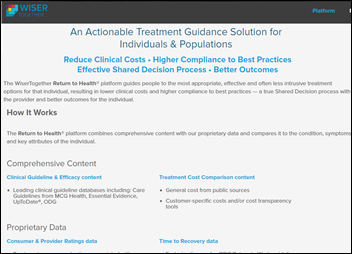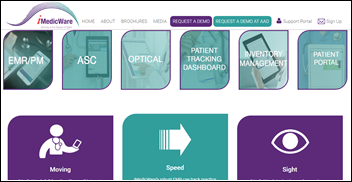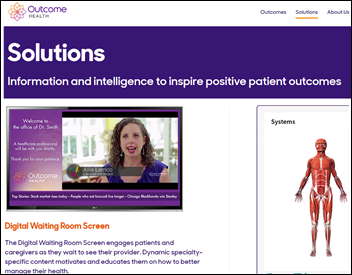G. Cameron “Cam” Deemer is president of DrFirst of Rockville, MD.

Tell me about yourself and the company.
I’m president of DrFirst. I’ve been with the company for about 13 years. DrFirst originally began as a standalone e-prescribing vendor about 17 years ago. Since then, we’ve migrated into a technology platform vendor serving over 300 EMRs. We have a large chunk of the hospital market, which typically uses our medication history services and our discharge prescribing. We’re now migrating also into the patient-facing application space.
What challenges remain for e-prescribing now that adoption is nearly universal?
At this point, most of the physicians who are ready to adopt have access to e-prescribing. There’s a couple of pockets that we found that are still issues. A lot of this came up when New York implemented the I-STOP program and suddenly we found pockets of physicians all over the state who had not yet adopted e-prescribing for one reason or another.
For instance, think about surgeons who typically write a very limited number of scripts. They don’t really see the need for an EMR. They’re not going to see the patients on a repeated basis, things like that. There were still those pockets out there where they still had a use for standalone e-prescribing because they’re not strongly committed to EMR use yet.
The other one is physicians after hours and away from the EMR who are still writing scripts on paper or calling it into the pharmacy because they don’t have a good mobile solution. That’s a problem we’re trying to solve right now.
What is the role of technology in addressing the opioid issue?
There’s an interesting transition happening literally right now. For the first time, state PDMP data — the controlled substance registries — are being made available in the workflow for physicians through a few vendors. I would say it’s experimental right now, trying to figure out what works best for the physicians. It’s the first time they haven’t been asked to go to a separate portal, log in, enter patient information, and go through all that, which they were reluctant to do.
Instead, in the process of writing a prescription, you’re able to see all the fills the patient has had for opioids. From a physician perspective, our experience has been they love that. It just becomes part of their workflow. They don’t have to do anything special to consume it.
What I believe will happen over time is that as physicians become more aware of patient behavior, the problem will shift back to illegal drugs. States must have some strategy there to nail down that side of the issue as well.
I think we can get the legitimate drug prescribing side well under control as we move this into the workflow.
The market has shown strong interest in tools for price transparency, electronic pre-authorization, specialty drug prescribing, and especially the electronic monitoring of drug adherence. How do you see that layer of intelligence that’s built on top of e-prescribing moving to the next level?
One of the most exciting things right now is price transparency. If you look at surveys, usually the number one complaint of patients is, I have no idea how much this is going to cost. Regularly you see that pricing issues and affordability are the top reasons for patient non-compliance.
If we’re going to deal with outcomes, we need to get price transparency under control. We’ve done quite a lot of work around that in the last couple of years. Humana rolled a program out nationally with us and we gained experience in how physicians respond. Since then, it brought several additional payers into that space to contribute their information.
Payers have tried to do that to some degree, but they are reluctant to share their actual drug costs with prescribers, they don’t necessarily have access to insurance-specific charges, and they struggle to account for differences in dose forms such as a tablet vs. a liquid.
You really nailed the problem. Until now, e-prescribing vendors and EMR vendors have had access to basic formulary and benefit information as a result of participating in the e-prescribing networks. That gave us a general understanding of how drugs are covered, but without patient-specific or employer-specific information. It varies dramatically among pharmacy benefit managers, PBMs, even with the same formulary. Certainly it does not include pricing information.
We knew we had to get better than that. How do you get the real information, down to the penny, of what the patient is going to pay? The only way to do that was to do an actual adjudication of the prescription before it is sent to the pharmacy. Let the physician know that this is the exact impact, specifically for this patient under whatever part of the patient’s coverage plan they happen to be in at the moment and considering everything that’s happened before with that patient.
The PBM is the only one that knows that, so you must do an adjudication. The real challenge for us and for the PBMs was, how do you do that? It’s different. They’re used to adjudicating pharmacy claims using the data that comes from a pharmacy. They’re used to receiving certain fields and responding with certain fields in a certain way. They’ve been doing that for years.
Now you’re moving upstream to the physician. Physicians don’t prescribe the same way the pharmacies dispense. For instance, a physician isn’t concerned with a specific NDC code as a pharmacy would be, but it’s a representative NDC. They just pick one that represents that drug name and that’s typically what we send to the pharmacy. The PBM is going to need something more specific than that to adjudicate it properly in their system.
There also can frequently be mismatches, where the EMR may not have kept its drug database up to date. The PBMs generally do, but they may not sync with what the EMR is using. There might be a difference in drug compendia, where the EMR is using one set of drug databases while the PBM uses one from a different company. Nobody’s done the work to sync that up or make sure they even know which compendium is being used.
The other challenge is about how physicians write quantities in prescriptions. The physician may have a way of describing the quantity of a drug that the pharmacist understands, but that is not what the PBM requires to adjudicate a prescription rather than a claim.
Even after a couple of years, the industry is still experimenting with that, to be able to make sure that the results get closer and closer to working every time rather than erroring out because something wasn’t understood. It’s getting much better as we allow people to experiment.
The other thing, how are they going to adjudicate that claim? The PBM industry has for years had the concept of a dummy claim. A pharmacy system vendor or a pharmacy could send a dummy claim just to make sure things were adjudicating correctly. Theoretically, you could run a physician’s prescription through that same process. Once you’ve cleaned up the prescription enough that it will process through that function, how do you connect to that function? It’s usually a different connection than what we would use out of an EMR or an e-prescribing system. It’s an NCPDP claims connection.
The response may not come back fast enough since it could be a slow system. If it does come back fast enough, you still only have one answer and you need several. You need to know not just that drug, but other drugs the physician could choose from that might have more favorable pricing for the patient if they want to see alternatives.
The dummy claim system isn’t made for that. It’s not made to hit it over and over and over and over with transactions. It’s made for occasional transactions. There’s some cost on the PBM side of building their system slightly differently to allowing a transaction to process multiple times for multiple drugs that are all related, but are more preferred than the drug that was submitted.
It’s a more complex logic involving systems that have a higher requirement on them. They still need to return their response very fast before the physician loses interest and moves on.
Is there opportunity in connecting technically sophisticated pharmacy chains like CVS and Walgreens back to prescriber systems?
That’s an interesting question. With what we’ve just been discussing about price transparency, that doesn’t quite apply in the same way, but there is a connection there.
What we’ve been discussing so far was getting plan information from the PBM. On the pharmacy side, there are other options for patients. Many of the pharmacies belong to programs that provide favorable cash pricing for a patient. A patient wouldn’t necessarily know anything about that favorable pricing if they have to pay cash, and today, many plans have shifted to high deductibles and HSA-based plans. In that kind of an environment, patients are often going to be out of pocket on their drug costs, so the ability to know that a discount would apply is very important.
That’s one of the things that we combine in our price transparency solution. Not just the PBM response, but also when applicable, discount information for the patient on some of the other networks that pharmacies participate in. In that sense, we’re bringing something that’s unique to the pharmacy into the physician workflow as well.
We address the general question of communication through a secure messaging solution that we’ve been implementing at pharmacies as well as in physician offices. They can have a two-way back and forth very efficiently.
Drug chains offer patients the chance to pay cash if that would be cheaper than their co-pay, often offering the patient coupons from third-party companies like GoodRx that offer PBM-type discounts. Should that be a factor?
We’ve partnered with those companies to make those plans available to patients, but we’ve moved it upstream. Instead of the pharmacist having to take time to do that, we let the patient walk in with that information ahead of time. That’s exactly what I was talking about — the discount programs the pharmacies have available.
Where do you see the company’s opportunities going forward?
Whenever something new like this enters the industry, it’s always interesting because there are incumbents in the industry. There are people who would like to play a bigger role and everybody tries to jump in on what’s new.
Two things slow down innovation. One is attempting to drive exclusive arrangements. They assume, “If I can get every payer to be exclusive with me, then all of the physicians will have work with me as well.” It’s a way to corner the market on physicians.
The problem with that, of course, is that everyone who would like to play in the price transparency space has only part of the market attached to them. Because of that, to drive these technologies out quicker and to get more innovation in the space, it’s much better to have non-exclusive relationships, where everybody can play with everybody for the role they can provide.
That’s a very important part of helping price transparency blossom in the country. We’ll see how it develops over time. Generally, people are uncomfortable with exclusive arrangements, but that’s the ugly business side of this space that people should be aware of when they’re deciding how they want to play here.
To get back to your question about possibilities, one of the neat things we’ve seen is that in addition to increasing the rate of compliance for patients because they’re already prepared for what they’re going to see at the pharmacy, it has a real strong tie into electronic prior authorization as well. Instead of thinking of it as price transparency, think of it as understanding how to maximize the use of your benefit or maximize the use of your plan.
If the physician is writing a drug that has a prior authorization component, maybe quantity limits, in the old days before this real-time connection, nobody really knew if any individual patient had already met the criteria. When you adjudicate the prescription real time and come back with the benefit information, you know exactly whether the patient has already PA’d on that drug, or if it’s step therapy, if they have already completed the first part of the step therapy. The PBM knows that already and can just say, prior auth is not required on this one.
We’ve seen a huge decrease in prior authorization requests as a result of freeing up this benefit information from the PBMs. That’s one of the things we’re exploring. How do we apply this pricing transparency workflow to reduce the number of times something else would take the physician out of the workflow?
I was talking about how everything happened at the pharmacy previously and now we’re moving that upstream into the physician, so that when they’re writing the prescription, they can consider price. We’re also moving it downstream to the patient. Maybe the physician was busy and didn’t take the time to have a conversation with the patient about their options. It may end up that sticker shock at the pharmacy causes the patient to decide just not to get the drug and not tell the doctor that they didn’t fill their prescription.
We’re taking that same pricing information out to the patient to let them better understand their options for different venues where they could consume the drug. Maybe they get a better deal at a preferred pharmacy, or maybe a home delivery has a more favorable price. Maybe it’s one of their local pharmacies that has a better cash price than the patient can get with their plan.
We feel that patients deserve a shot at the information as well. We’re getting a huge response from patients who love the ability to see that and then have a conversation with their doctor if they see something they think would work better for them in terms of affordability.
Do you have any final thoughts?
This is an exciting new opportunity. It’s too soon to squeeze it into a one-size-fits-all space. A lot of talk in the industry is about trying to make everyone use a standard transaction for this. It’s really not the time for that. People are experimenting with APIs and different formats for prescriptions. We really ought to let it bloom and let innovation flow. This is so important that we must get it right, and the best way to get it right is to try a lot of different things.




























































































Re: Dr Z. Great story, but whatever happened to professional courtesy???